Question
Irina has some solid building blocks.
(a) Write down the mathematical name of this solid.
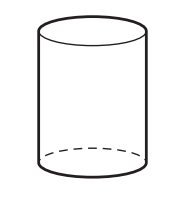
Answer/Explanation
Ans: Cylinder
(b) Irina describes the shape of a different block.
She says:
It has 12 edges and 8 vertices. All the faces are the same shape.
Write down the mathematical name of this solid.
Answer/Explanation
Ans: Cube or cuboid
(c) The diagram shows the end face of another block.
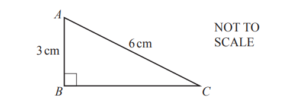
(i) Show that BC = 5.2 cm, correct to 1 decimal place.
Answer/Explanation
Ans: \(\sqrt{6^{2}-3^{2}}\)
5.19…
(ii) Find the area of triangle ABC.
Answer/Explanation
Ans: 7.79 to 7.8
(iii) This block is a triangular prism with length 8cm.
Calculate the volume of the block.
Answer/Explanation
Ans: 62.4
(d) The diagram shows another building block.
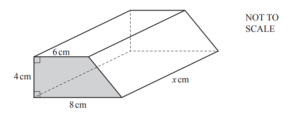
(i) Calculate the area of the end face of this block.
Answer/Explanation
Ans: 28
(ii) The volume of this block is 336 cm3.
Find the value of x.
Answer/Explanation
Ans: 12
Question
(a) The grid shows part of the net of a cuboid.
Complete the net.
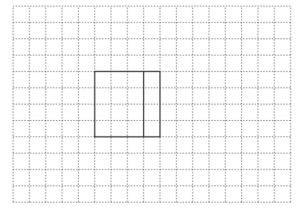
Answer/Explanation
Ans: correct net drawn
(b) The volume of another cuboid is 60cm3.
Each side is a whole number of centimetres long.
Write down a possible set of dimensions for the cuboid.
Answer/Explanation
Ans:
60,1,1 or 30,2,1 or 20,3,1 or
15,4,1 or 15,2,2 or 12,5,1 or
10,6,1 or 10,3,2 or 6,5,2 or
5,4,3
(c) Each side of a cube has length 2cm.
Work out the total surface area of the cube.
Give the units of your answer.
Answer/Explanation
Ans: 24 cm2
(d) Change 9cm2 into mm2.
Answer/Explanation
Ans: 900 mm2
(e) The diagram shows a triangle.
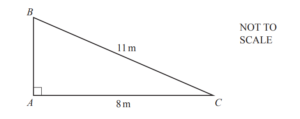
(i) Calculate the length AB.
Answer/Explanation
Ans: 7.55 or 7.549….. m
(ii) Use trigonometry to calculate angle ACB.
Answer/Explanation
Ans: 43.3 or 43.34
(f)
The diameter of the large circle is 13cm.
The radius of the small circle is 2cm.
Calculate the shaded area.
Answer/Explanation
Ans: 120 or 120.16 to 120.2 cm2
Question
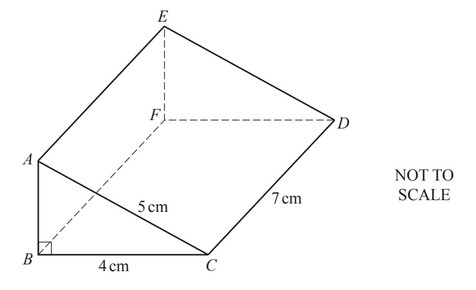
The diagram shows a solid in the shape of a triangular prism.
AC = 5cm, BC = 4cm and CD = 7cm.
Angle ABC = 90°.
(a) What does the word prism tell you about the solid in the diagram?
(b) Show that AB = 3cm.
(c) Calculate the volume of the prism.
Give the units of your answer.
(d) On the 1 \(cm^2\) grid, complete the net of the prism.
Two faces have been drawn for you.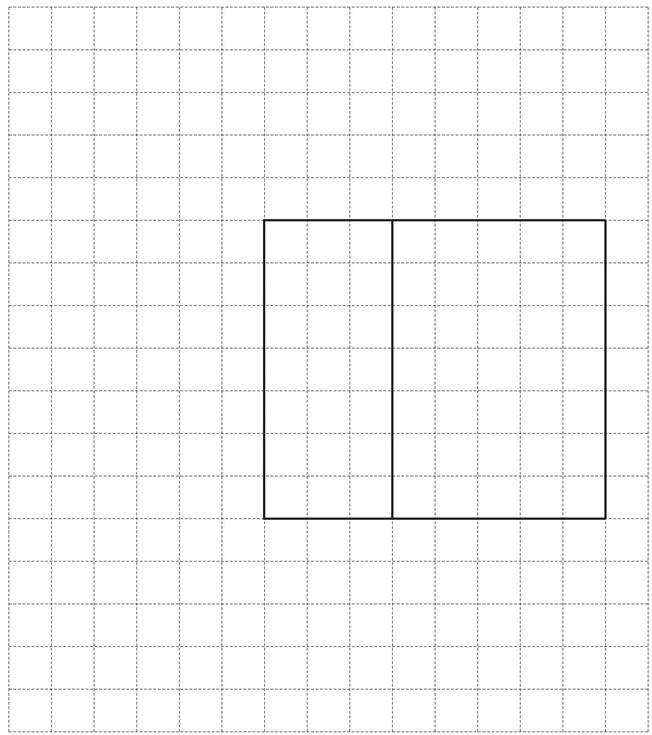
(e) Calculate the surface area of the prism.
………………….. \(cm^2\)
Answer/Explanation
Ans:
(a) constant cross-sectional area oe
(b) \([AB^2]+4^2=5^2\)
\([AB]=\sqrt{5^2-4^2} = \sqrt{9}\)
(c) 42
\(cm^3\)
(d) correct net drawn
(e) 96
Question
Nora makes a birthday cake.
(a) Nora has a packet containing 250g of cherries.
She uses \(\frac{7}{10}\) of the cherries in the cake.
Find the mass of cherries she has left.
………………………………………. g
(b) The cake is made by putting a small cylinder of cake on top of a large cylinder of cake.
The radius of the large cylinder is 15cm.
The radius of the small cylinder is 8cm.
The height of each cylinder is 10cm.
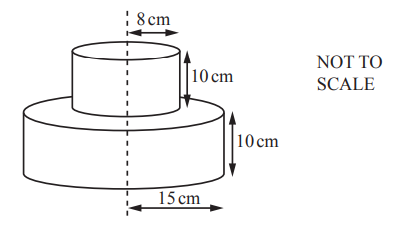
(i) Calculate the total volume of the cake.
\(……………………………………cm^{3}\)
(ii) Nora wraps a ribbon around the large cylinder.
The ribbon is 4 cm longer than needed to go all the way around this cylinder.
Calculate the length of this ribbon.
……………………………………. cm
(c) The mass, m grams, of the cake is 1250g, correct to the nearest 10g.
Complete this statement about the value of m.
\(………………… \leq m < …………………\)
Answer/Explanation
(a) 75
(b)(i) 9080 or 9079 to 9081
(ii) 98.2 or 98.3 or 98.24 to 98.26
(c) 1245, 1255
Question
(a)
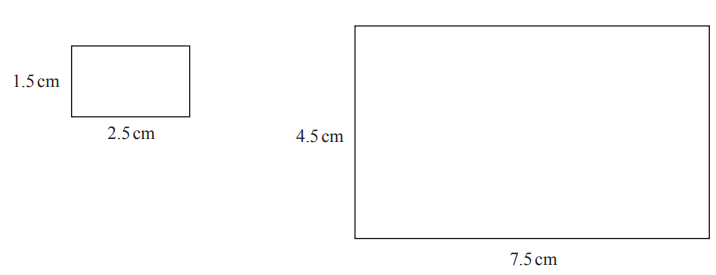
(i) Explain why these rectangles are mathematically similar.
……………………………………………………………………………………………………………………………………
……………………………………………………………………………………………………………………………………
(ii) How many times bigger is the area of the large rectangle than the area of the small rectangle?
………….
(b)
The diagram shows a net of a cube.
(i) The square labelled B is the base.
Write the letter T in the square that is the top of the cube.
(ii) On the grid, draw a different net of this cube.
(c) The diagram shows a cuboid.
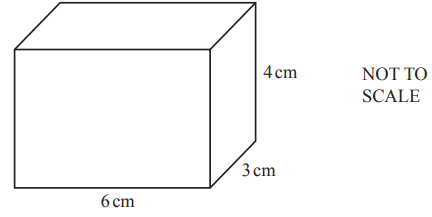
(i) Work out the surface area of this cuboid.
………………………………….. \(cm^{2}\)
(ii) Work out the volume of this cuboid.
………………………………….. \(cm^{3}\)
(iii) Write down the dimensions of a different cuboid that has the same volume as this cuboid.
………………… cm by ………………… cm by ………………… cm
Answer/Explanation
(a)(i)One rectangle is an enlargement of the other.
(ii)9
(b)(i) 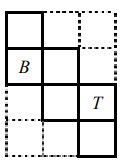 in correct square
in correct square
(ii)A different correct net drawn
(c)(i)108
(ii)72
(iii)3 positive numbers (other than 3,4,6) with product 72
Question
(a) Write the number four hundred and eighteen thousand and seventy two in figures.[1]
(b) Write down all the factors of 16.[2]
(c) Write down a prime number between 30 and 40.[1]
(d) Find the value of
(i) \(\sqrt{729},\) [1]
(ii) 183, [1]
(iii) 70.[1]
(e) Saskia has \($\)600.
She spends \(\frac{1}{5}\) of the \($\)600 on a coat and gives \(\frac{1}{3}\) of the \($\)600 to her son.
What fraction of the \($\)600 does she have left?
Give your answer in its simplest form.[3]
(f) Find the lowest common multiple (LCM) of 15 and 27.[2]
(g) Write 432 as the product of its prime factors.[2]
(h) Ella invests \($\)4000 for 3 years at a rate of 1.2% per year compound interest.
Calculate the value of her investment at the end of the 3 years.
\($\)[3]
Answer/Explanation
Ans:
4(a) 418072
4(b) 1 2 4 8 16
4(c) 31 or 37
4(d)(i) 27
4(d)(ii) 5832
4(d)(iii) 1
4(e) \(\frac{7}{15}\) cao
4(f) 135
4(g) 24 × 33 or 2 × 2 × 2 × 2 × 3 × 3 × 3
4(h) 4145.7[3] or 4145.70 or 4150 or 4146
Question
The diagram shows a right-angled triangular prism.
(a) On the \(1 cm^{2}\) grid, complete the net of the prism.One face has been drawn for you.

(b) Work out the surface area of the prism.
…………………………………… \(cm^{2}.\)
(c) Work out the volume of the prism.
…………………………………… \(cm^{3}.\)
Answer/Explanation
(a) Correct net
(b) 84
(c) 36
Question
The diagram shows the net of a triangular prism on a \(1cm^{2}\) grid.
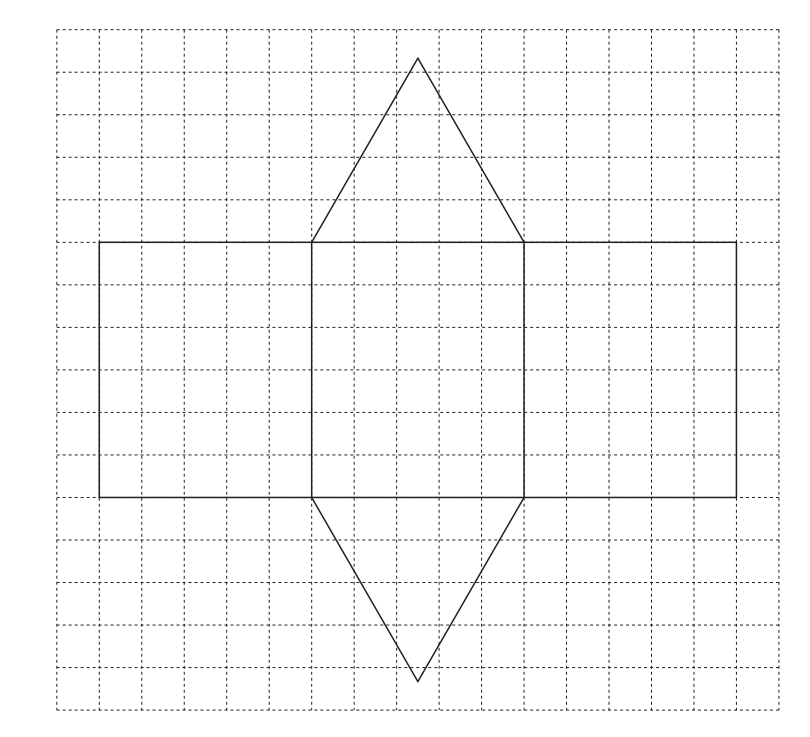
(a) Write down the mathematical name for the type of triangle shown on the grid.
………………………………………….
(b) (i) Measure the perpendicular height of the triangle.
…………………………………….. cm
(ii) Calculate the area of the triangle.
…………………………………… \(cm^{2}\)
(iii) Calculate the volume of the triangular prism.
……………………………………\( cm^{3}\)
Answer/Explanation
(a) Equilateral
(b)(i) 4.1 to 4.5
(ii) 10.25 to 11.25
(iii) 61.5 to 67.5
Question
(a) A closed box, in the shape of a cuboid, has length 5cm, width 4cm and height 2cm.
(i) Draw a net of the box on the 1cm2 grid.

Answer/Explanation
Ans: Correct ruled net
(ii) A container is a cube with volume 1m3.
Work out the maximum number of these boxes that can be packed into this container.
Answer/Explanation
Ans: 25 000
(b) A shop sells three different sized boxes of rice.
The boxes all have the same cost per kilogram.

(i) Work out the cost in rupees of box B.
Answer/Explanation
Ans: 144
(ii) $1 = 64 rupees.
Calculate the mass of box C.
Give your answer in kilograms.
Answer/Explanation
Ans: 2.1
(c) Change 75cm3 into litres.
Give your answer in standard form.
Answer/Explanation
Ans: 7.5 10−2 × cao
Question
(a)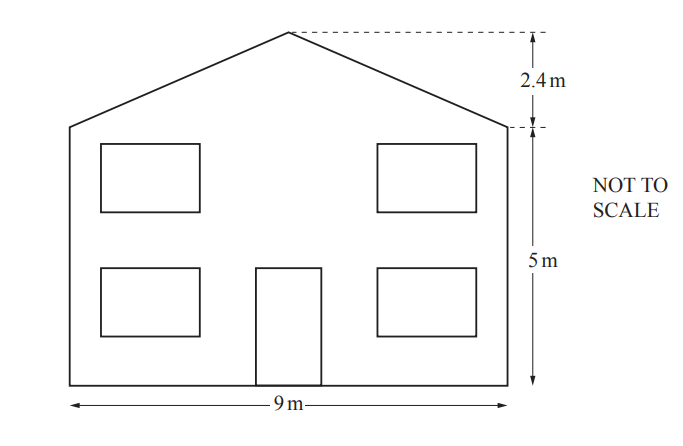
The diagram shows the front of Pranav’s house.
(i) Work out the total area of the front of his house.
……………………………………..\( m^{2}\)
(ii) The door is 0.9m wide and 2.1m high.
Each of the four windows are 1.5m wide and 1.2m high.
Work out the total area of the door and the four windows.
……………………………………..\( m^{2}\)
(iii) Pranav paints the front of his house but not the door and not the four windows.
Work out the area he paints.
……………………………………..\( m^{2}\)
(b) Pranav paints a wall of area \(53m^{2}.\)
One litre of paint covers an area of \(4.5m^{2}.\)
Paint is sold in 2.5 litre tins, each costing \($24.75 .\)
Pranav buys the least number of tins to paint this wall.
Work out the cost of the paint.
\($ \)………………………………………….
Answer/Explanation
(a)(i) 55.8
(ii) 9.09
(iii) 46.7 or 46.71
(b) 123.75
Question
(a) A closed box, in the shape of a cuboid, has length 5cm, width 4cm and height 2cm.
(i) Draw a net of the box on the 1cm2 grid.
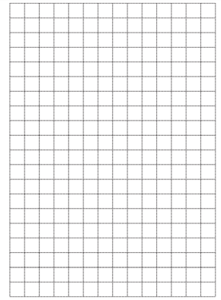
Answer/Explanation
Ans: Correct ruled net
(ii) A container is a cube with volume 1m3.
Work out the maximum number of these boxes that can be packed into this container.
Answer/Explanation
Ans: 25 000
(b) A shop sells three different sized boxes of rice.
The boxes all have the same cost per kilogram.

(i) Work out the cost in rupees of box B.
Answer/Explanation
Ans: 144
(ii) $1 = 64 rupees.
Calculate the mass of box C.
Give your answer in kilograms.
Answer/Explanation
Ans: 2.1
(c) Change 75cm3 into litres.
Give your answer in standard form.
Answer/Explanation
Ans: 7.5 10−2 × cao
Question
(a)
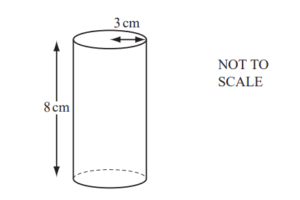
A cylindrical drinking glass has radius 3 cm and height 8 cm.
(i) Calculate the volume of water the glass holds when it is filled to the top.
Give the units of your answer.
Answer/Explanation
Ans: 226 to 226.224 cm3
(ii) Water is poured into a number of these glasses from a jug containing 1.5 litres.
Each glass has a horizontal line 2 cm from the top.
Calculate how many of these glasses can be filled up to the line from the jug.
Answer/Explanation
Ans: 8 cao www
(b) A cylindrical pipe has a circumference of 16 cm.
Calculate the diameter of the pipe.
Answer/Explanation
Ans: 5.09 (5.092 to 5.10)
(c) A cuboid measures 6 cm by 5 cm by 4 cm.
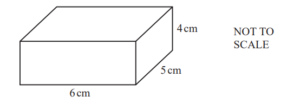
Work out the surface area of the cuboid.
Answer/Explanation
Ans: 148 cm²
(d) 1m3 of copper has a mass of m kg.
The volume of one copper sphere is v m3.
Write down an expression for
(i) the mass, in kilograms, of one sphere,
Answer/Explanation
Ans: mv oe
(ii) the mass, in kilograms, of s spheres,
Answer/Explanation
Ans: msv oe
(iii) the mass, in grams, of s spheres.
Answer/Explanation
Ans: 1000 msv oe
Question
(a) A water tank in the shape of a cuboid measures 55 cm by 40 cm by 75 cm.
(i) Find the volume of the tank.
Answer/Explanation
Ans: 165 000
(ii) Write down the volume of the tank in litres.
Answer/Explanation
Ans: 165
(b) Another water tank contains 260 litres.
(i) The tank is emptied at a rate of 25 litres per minute.
Work out the time taken to completely empty the tank.
Give your answer in minutes and seconds.
Answer/Explanation
Ans: 10 minutes 24 seconds
(ii) 260 litres is given correct to the nearest 10 litres.
Write down the lower bound of this amount.
Answer/Explanation
Ans: 255
(c) A different tank is in the shape of a cube.
It has a volume of 27 000 cm3.
Find the height of this tank.
Answer/Explanation
Ans: 30
Question
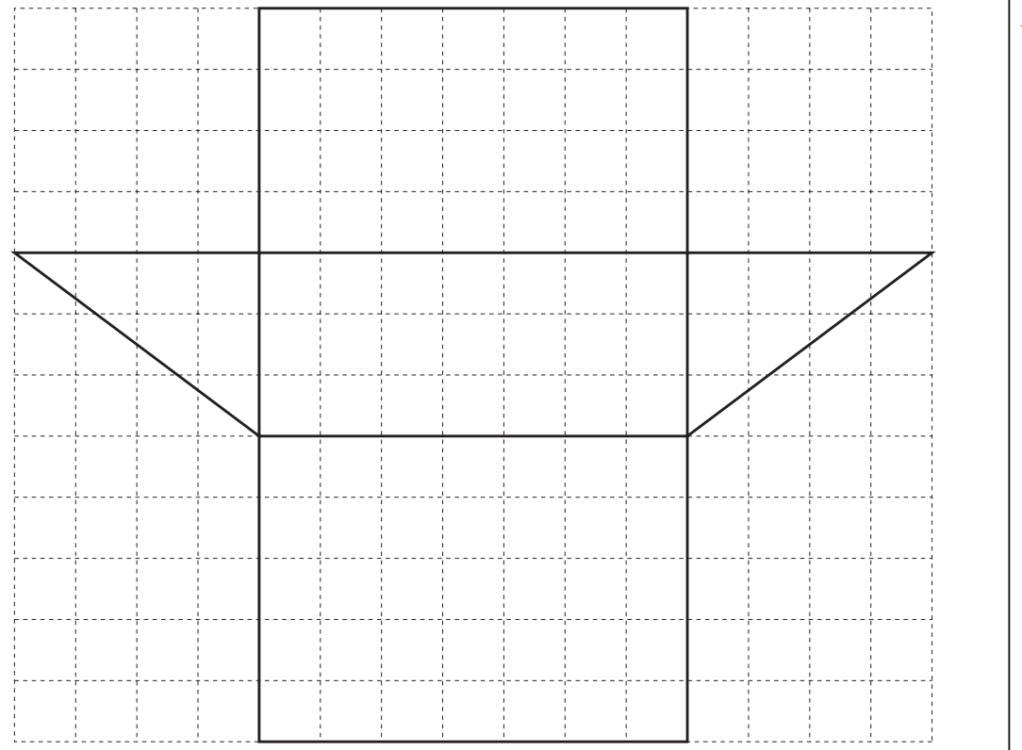
The shape above is the net of a solid drawn on a 1 cm square grid.
(a) Write down the geometrical name of the solid
(b) Find the perimeter of the net.
(c) Work out
(i) the area of one of the triangles,
(ii) the volume of the solid.
(d) A cuboid of length 4 cm and width 3 cm has the same volume as the solid.
Calculate the height of the cuboid.
Answer/Explanation
(a) Triangular prism
(b) 50.4
(c)(i) Area =\(\frac{1}{2}\times 4 \times 3\)
=6
(ii) Volume= \(Area\times 7\)
= 6.7
=42 \({cm}^3\)
(d) Given:
Volume of solid= 42\({cm}^3\)
Volume of Cuboid= l.b.h
where, l is length
b is breadth
and h is height
A/Q
Volume of solid= Volume of cuboid
42= l.b.h
42=4.3.h
\(h=\frac{42}{12}\)
h= 3.5 cm
Question
(a) Bruce mixes blue and yellow paint to make green paint. He uses blue and yellow paint in the ratio blue : yellow $=7: 3$.
(i) He makes 15 litres of green paint.
How many litres of yellow paint does he use?
(ii) He buys the yellow paint in tins. Each tin contains 2 litres of paint. Write down the number of tins of yellow paint he buys.
(b) Tins of red paint cost $9.25 each. In a sale, the shop reduces the price by 12%.
(i) Calculate the sale price.
(ii) Bruce buys 4 tins of red paint in the sale. How much does he pay?
(iii) Before the sale, he bought 5 tins at $9.25 each. Calculate how much he paid for these 5 tins.
(iv) Use parts (b)(ii) and (b) (iii) to find the average (mean) price he paid for a tin of red paint.
▶️Answer/Explanation
(a) (i) 4.5
(ii) 3
(b) (i) 8.14
(ii) 32.56
(iii) 46.25
(iv) $8.75(6 \ldots)$ or 8.76

